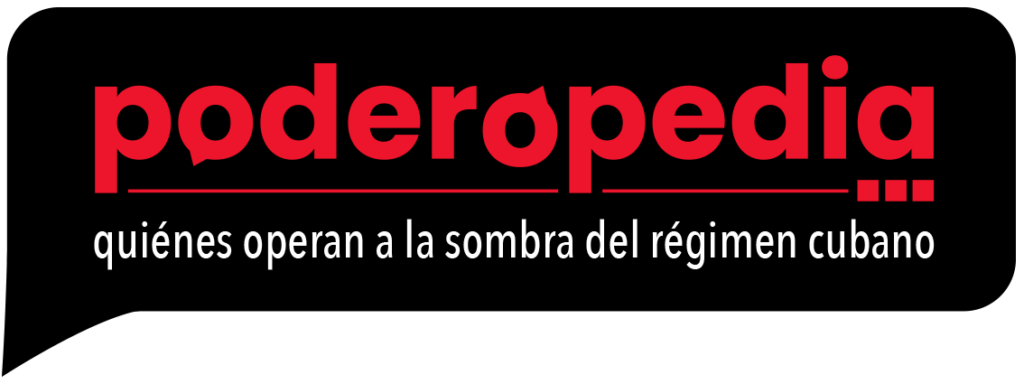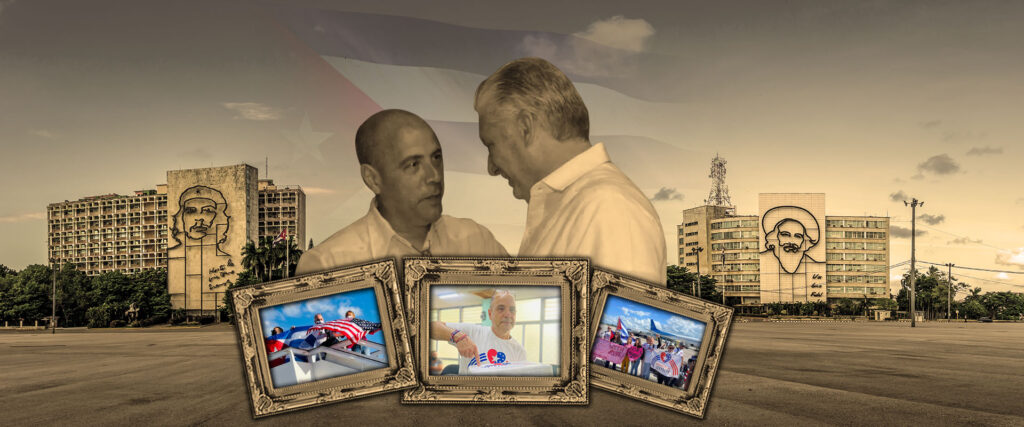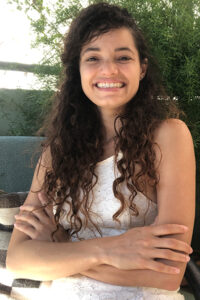Cynthia de la Cantera Toranzo | October 2, 2023
The teacher is standing at the front of his classroom at North Creek High School, a public high school in the city of Bothell, in the western part of the state of Washington. Right behind him on the wall hangs a Cuban flag that is at least one meter long. As he speaks, the teacher gestures, opens his arms, marks imaginary points, draws a line between them, and says:
“We are going to build a big bridge of love, of love, from here to Havana. Who is on that bridge with me? Who is on that bridge with me?” A group of teenagers who laugh and applaud respond in chorus: “Yes!”
“We are going to have a concert in Havana, and in that concert in Havana, you will be singing with young Cubans, with young people in Cuba. And that dream of singing in Havana, of going… is a dream that will come true. Who is in the dream with me there?!”
“Yes!”
Cuban-American teacher Carlos Lazo, who often documents all activities with his students, landed with them in Havana for the first time in April 2018. The group of 40 people, including some parents, traveled with the idea that the students would sing some Cuban trova songs that the teacher teaches in his Spanish classes.
As recognized by Lazo himself, that trip had no more significance than a mere Facebook post shared with the 200 friends he had at the time, and a note from King 5 News, a local Seattle media outlet.
But two months later, a video of the teacher and his students went viral, reaching over 4,000 likes. The avalanche of comments and messages led Lazo to create a page to continue sharing his activities as a teacher, separate from his personal account.
To this day, five years later, he has 121,000 followers. He is known on social media, among families, and by the Cuban government for undertaking projects with his students titled “Fábrica de Sueños” (Dream Factory) and “Puentes de Amor” (Bridges of Love, PDA by its Spanish acronym), through which he manages and sends tons of food and medicine to Cuba. He is also known for his activism against U.S. sanctions on the island, to the point that OnCuba, a pro-regime media outlet, refers to him as “one of the biggest activists for normalization.”
Lazo’s sympathy for the Cuban government dates back nearly three decades and has almost always been expressed through his anti-embargo stance. But it was between 2019 and 2021 that he began to actively denounce these policies, amid the rise of his projects and with media impact backed by Cuba’s official press and allies. Since then, the reach has been such that Lazo has met with President Miguel Díaz Canel for two consecutive years, in 2021 and 2022, accompanied by some students and other members of PDA.
This government recognition is what sets PDA apart from other initiatives by Cuban emigrants who, like Lazo, invest their own time and resources in the same work but maintain a critical stance against the government. Without that approval, no independent or foreign project has been able to donate to Cuba on the scale that PDA does, with the support of other organizations. Much less deliver donations personally to public health centers.
That’s why the teacher is such a controversial figure. He has thousands of supporters who commend him for his humanitarian work, alleviating the shortage of medicines and supplies, and sponsoring families who have lost their homes and belongings in natural disasters, while thousands of others accuse him of serving the interests of the Cuban government.
From hate to love: Lazo’s narrative
The professor has recounted the story of how he came to the United States several times. In 1988, at the age of 23 and fed up with Cuba and with what he then considered the “worst country in the world,” the professor attempted to leave on a raft. That time, he failed and ended up serving a year in prison, sanctioned for the crime of illegal exit from the national territory. In 1991, he tried again and managed to reach Florida when U.S. border guards rescued him after drifting at sea for three days.
“I went through many unpleasant situations, partly a result of the times we were living in, the dynamics of Cuban society at that moment. And yes, I felt hatred. (…) I ended up hating Cuba, hating the Cuban people; I feel no shame saying it because today I love the country and its people,” the professor told Alma Mater magazine.
These terms of love and hatred are quite familiar to many Cubans. Days after the protests on July 11th, Díaz-Canel appeared on national television, claiming that the demonstrations were motivated by media campaigns filled with hatred and fake news. Since then, the president, his wife Liz Cuesta, government officials, state workers, university students, and thousands of bots refer to those who support the Revolution as “those who love and build,” while the opposition represents “those who hate and destroy.”
Those who were once “bourgeois,” “worms,” “counter-revolutionaries,” “dissidents” are now “haters.” For decades, Cubans have been exposed to the constant repetition of these ideas in the media, speeches, and public billboards. It’s how the regime discredits its critics. The government of Díaz Canel, whose motto is continuity (of the Castros), redefined the expressions of love and hate based on an article by José Martí, a Cuban statesman and intellectual, one of the most prominent symbols of national independence.
Carlos Lazo also appropriates this language to talk about his relationship with his homeland and his conflicts as an émigré.
In a Facebook post, he recounted that the point at which he began to move away from “hatred” was a conversation with his father when he visited him at his home in Miami. A year later, in 1994, that reconciliation became even stronger when Lazo returned to the country for the first time after the regulations prohibiting the entry of those who had left illegally had changed.
“And I could never go back to hatred, I know that you can return from hatred,” the professor said. Then, in 1998, he moved to Seattle to study and get away from the “haters” in Miami. There, he graduated in nursing, which qualified him to serve in the National Guard in Iraq.
Lazo told the U.S. Senate what would happen next. Between 2004 and 2005, he tried to travel to Cuba from Miami on two occasions to see his two older children, after spending several months at war. But in both cases, the U.S. government prevented him because the administration of George W. Bush had restricted the travel of Cuban Americans to once every three years.
So, the professor explained how these measures affected him and that the sanctions did not make exceptions for humanitarian reasons, such as visiting sick family members. “I beg you to lift the restrictions so that Cuban families on both sides of the Florida Strait can reunite,” he said.
The opportunity to testify before the Senate in 2007 was made possible thanks to the guidance of Sarah Stephen, one of the key figures in the reestablishment of relations between the two countries. Stephen, an American human rights activist, was the director of the Center for Democracy in the Americas (CDA) at that time, an organization she had founded a year earlier. CDA promotes engagement between the U.S., Cuba, and other authoritarian countries in the region, such as Venezuela.
According to the professor, even in those years in the early 2000s, he had become “one of the many voices calling for the lifting of those sanctions. Since then, and in the last almost 20 years, I have been what I am today, only that, thanks to the song in 2018 (Cuba Isla Bella), my work has become more widely known.”
He stated that he has had a more public role since 2019 when Donald Trump approved new restrictions, a significant setback in the policy of rapprochement initiated by the Barack Obama administration.
And indeed, since that date, Lazo has achieved a lot of reach on social media, which also shows how much time he dedicates to his activism in PDA. He has traveled to Cuba more than 20 times (an approximate calculation based on his Facebook posts), with various groups of American students and citizens. In the videos he shares, one can see them visiting shelters and marginalized neighborhoods in the capital, community projects, pediatric hospitals in Santiago de Cuba and Guantánamo, and farmers huts in Viñales, one of the most important ecotourism destinations in the country.
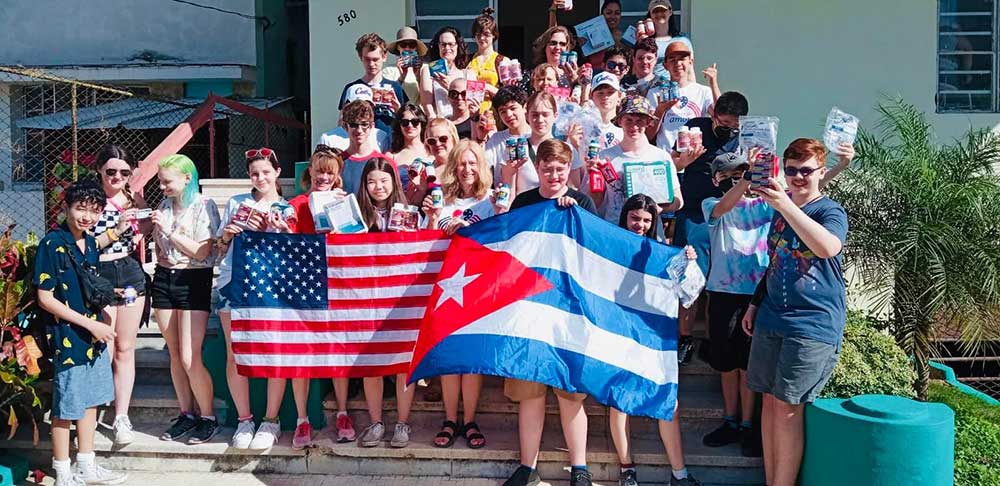
Always accompanied by members of PDA, and some of their family members, the professor cycled nearly 5000 kilometers through the northern United States, from Seattle to the White House. He walked about 1700 kilometers from Miami to Washington and, a few months later, another 100 kilometers from Assisi to Rome, Italy. He also represented the island at official events abroad.
In addition, together with PDA, he accompanied the caravans against the blockade, organized by left-wing groups and Cuban émigrés who support the Cuban government. Not only in cities in the United States, such as Miami, Las Vegas, or New York, but also in Europe, such as Madrid, Brussels, and London. He has met with Democrats who support the policy of thawing relations, people like Emily Mendrala, a former State Department official and current senior advisor on migration at the White House. Lazo visited her on July 26, 2021, Cuba’s National Rebellion Day and the most prominent anniversary of the Revolution, to deliver more than 17,000 signatures collected in his campaigns in favor of ending the sanctions.
The professor stated in a Facebook livestream that PDA is not a political organization but one with a “humanitarian vision.” However, he mentioned that beyond the fact that people know PDA for its humanitarian work, its mission is to educate the American public about the need to “lift the blockade, to have good relations between both countries, because it is beneficial for both countries, both peoples.”
The stance on the embargo marks political differences beyond those who are in favor or against the policy. According to the regime’s narrative, those who support sanctions are automatically against the government and the people, and vice versa. In reality, this range also includes those who advocate for a change of government and system but do not agree with sanctions due to the cost they impose on the population. And those who believe that the United States should only negotiate the dismantling of the embargo in exchange for civil and political freedoms on the island.
Lazo’s stance is that of an émigré with zero questioning or barely criticizing the Cuban government for the scarcity crisis that he himself is trying to alleviate. In the weekly presentations that he posts on social media, and in his interviews, Lazo always focuses on the blockade as the sole cause of the lack of medicines and supplies. This way, he helps spread the government’s official discourse while nurturing the image of the supposedly good relations he maintains with his community abroad.
With this discourse, he launches PDA campaigns, in collaboration with other organizations, to raise money and donations. Later, Lazo and other members are welcomed at the airport by the official press and some public health officials. Media coverage then includes reports on the delivery of these donations to various pediatric hospitals in the country. Lazo represents the figure of the émigré who left Cuba but does not forget his people.
Meanwhile, this same official press conveniently ignores dozens of initiatives by Cubans residing in the country and émigrés working from various cities in the United States and Europe. This includes the initiatives of Cubans who have mobilized, just like Lazo and PDA, for disasters such as the tornado that struck Havana in 2019; hurricanes; the COVID-19 pandemic, and the explosion of the Saratoga hotel in 2022, and who have also provided donations of money, food, clothing, and medicines to vulnerable communities, including children, the elderly, transgender individuals, and others in need.
However, these groups find it more difficult, if not impossible, to send medicines and other basic products. They usually use the personal luggage of people traveling to Cuba as a means, so the impact is always smaller than that of PDA, which transports its donations on cargo planes.
In addition, Cuban State Security has prevented some groups residing in the country from directly delivering the donations they collect with their efforts. This, even during emergency situations, such as the tornado that affected several capital municipalities in January 2019, or the explosion of the Saratoga hotel in May 2022.
Massy Carram, one of the coordinators of the group “Solo el Amor,” organized a donation collection for neighbors living near the hotel. But when she tried to personally deliver the cargo, several State Security officers prohibited her from doing so. She said, “Apparently, ‘dissidents’ do care about people who are left homeless.”
In his speech, Lazo ignores these issues, just as he ignores the internal causes of the current crisis, which includes government management, and the collapse of virtually all sectors, except the military sector. The professor rarely analyzes the decisions made by the government on the island, which have led to the dollarization of the economy, with a 45 percent inflation rate in just the last year, reduced production capacity, and therefore, greater dependence on imports. He has also not mentioned anything about the more than 1000 political prisoners, nor the demonstrations and protests that have made headlines in the country since the massive ones on July 11, 2021 (11J). And he has never referred to any of the summons for interrogations that activists and independent journalists endure.
He even avoids some aspects related to the embargo. While he explains in his campaigns that Cuba cannot access certain products or credits in the international market due to sanctions, he does not mention that, although the exchange between countries is limited, the U.S. has exported goods to Cuba since 2002 worth about $7.234 billion USD. He also does not mention that this trade is vital for the island, as frozen chicken meat has topped the list of these goods since 2009, which is one of the basic proteins in Cuban households.
Furthermore, the professor overlooks the fact that between 2021 and 2022, the number of U.S. permits for shipments to Cuba for humanitarian reasons increased from $4.2 billion to $7.6 billion (which does not necessarily correspond to the export values).
A recent investigation by The New York Times reveals how the Chinese government partners with foreign media and influencers to disguise propaganda as independent content. Cuba, which consults with the giant Asian country on cybersecurity matters, has similar practices with individuals, including Lazo.
The resonance of these publications, shared thousands of times through fake accounts, gives artificial relevance to certain opinion trends, such as the idea that there is a widespread demand for the lifting of the embargo even outside of Cuba, or that Americans oppose their own government in this regard, when the majority of Cuban Americans support and vote for the Republican Party.
Whatever Lazo’s reasons may be, he chose not to respond to questions for this report. The fact remains that his narrative aligns perfectly with the main arguments of the regime’s propaganda.
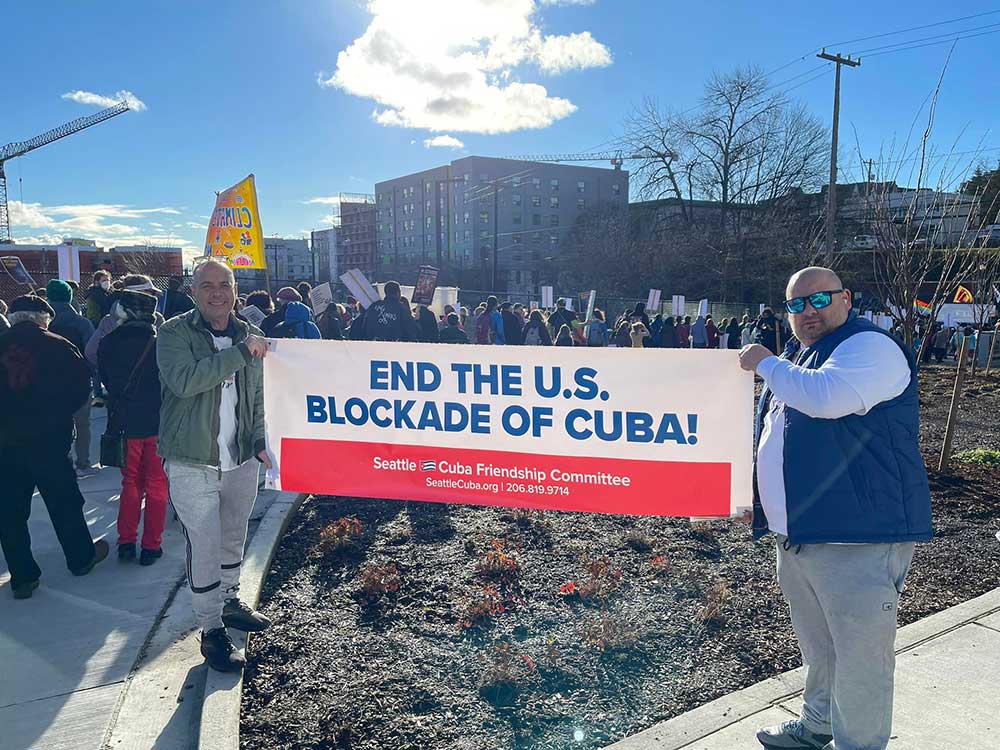
With whom does Puentes de Amor associate itself?
In November 2020, less than three years after the first journey that gave rise to the projects “Fábrica de Sueños” and “Puentes de Amor,” Carlos Lazo registered the second one as a non-profit organization in the state of Washington.
Entities of this kind, if they want to be exempt from paying taxes in the United States and meet certain requirements, such as generating at least $50,000 in annual income, must comply with transparency rules. These rules mainly involve filing a form known as Form 990. In this form, the non-profit organization must declare its income and specify who benefits from its donations. They are not obligated to disclose the source of their funds.
To date, “Puentes de Amor” does not appear to have filed Form 990, as could be confirmed by consulting databases that compile financial information about non-profit organizations.
Therefore, there is no information available regarding how much money the organization receives and donates. However, Carlos Lazo’s statements, press releases, and campaign records on platforms like GoFundMe provide some data on the income of “Puentes de Amor.”
The figure, which is undoubtedly underreported, is around $690,000 USD. This includes the funds raised by students for the first trip to Cuba and a large-scale campaign that concluded in July 2023, in collaboration with another non-profit organization.
The organization is predominantly composed of Cuban émigrés. In an interview, the professor mentioned that the only condition for belonging to “Puentes de Amor” is to want the sanctions on the Cuban people to be lifted. He stated that ideological definitions don’t matter in “Puentes de Amor,” but he emphasized that those who “love and build” are welcome, ignoring the fact that this phrase is how the regime defines those who support its policies.
On another occasion, Lazo mentioned that Cuban professors residing in Spain, China, and the United States work for “Puentes de Amor” to ensure that the “bridge of love” continues. However, he has barely formally introduced the organization’s board of directors. Some of them are his family members, others are friends or close colleagues, as can be seen in the photos the professor posts on Facebook. They all share a common commitment to the growth of “Puentes de Amor” and publicly express their anti-embargo stance.
One of the individuals initially contacted by the professor when planning the first trip with his students was Collin Laverty, a Cuban-American entrepreneur with a degree in Political Science who worked for nearly 5 years at the Center for Democracy in the Americas (CDA). This is the same organization that supported and guided Lazo a decade ago when he testified before the Senate. At that time, Laverty was running his company, Cuban Education Travel (CET), which describes itself as “the leading people-to-people tour operator,” the program through which the U.S. government authorizes its citizens to travel to Cuba in groups. As far as Lazo has stated, CET assisted the project the first time by covering the expenses of one of the students.
Founded in 2012, the first five years of CET included the period of thaw in U.S.-Cuba relations. During that time, Laverty organized corporate retreats on the island for companies like Netflix and Spotify; events for the U.S. Chamber of Commerce, and for companies like Airbnb. In 2018, he traveled to Cuba with Mendrala -the former State Department official who received Lazo in 2021 and with whom he worked at CDA- as part of a delegation of U.S. congressmen who met with Cuban Foreign Minister Bruno Rodríguez Parrilla.
CET offers experiences ranging from volunteering to tours of mansions in Havana, meetings with Cuban entrepreneurs and artists, and even organizes “high-level luxury” events, with expertise in managing “private flights and security details” through a subsidiary called CET Luxury.
On its website, CET claims to be “a leading voice in ending the embargo on Cuba.”
Between 2015 and 2019, Laverty founded a non-profit organization and two other companies: Havana Strategies, a “boutique consultancy” on foreign investment in Cuba, and Terapia Productions LLC, which is dedicated to the production of cultural events and artistic performances. As of today, only Terapia Productions remains active.
Regarding “Puentes de Amor,” Laverty responded that he has “nothing to do” with the organization, stating, “I don’t think I have much to offer because I don’t know much about ‘Puentes de Amor’.”
Another person listed on the board of “Puentes de Amor” is Milena Recio, a journalist and current editorial director of OnCuba, a magazine owned by Cuban-American entrepreneur Hugo Cancio’s company, Fuego Enterprises. This independent magazine is the only one legally recognized by the Cuban regime and has provided extensive coverage of Lazo and the activities of “Puentes de Amor” since its inception. In August, one of Cancio’s companies obtained a license from the Department of the Treasury to export trucks, buses, and agricultural machinery to Cuba, a development that Lazo announced on Facebook as “a hole in the blockade.”
Completing the core leadership are Lazo’s wife, Lissete Lazo, his sister-in-law Nadia Delgado, and Abel Martínez, who declared a year ago that he no longer has any relationship with “Puentes de Amor.” In addition, the registration includes three other individuals residing in the United States who also share content related to the regime’s propaganda on their social media: Yadira Lugo, Lynn León, and Alejandro Garballo.
Until the closing of this article, none of these individuals have responded to the request for statements for this investigation.
As can be seen in the photos that Lazo uploads to his social media, of these last three, it is Lynn León who works more regularly with PDA. Based in Miami, she personally assists in sending donations, and travels to Cuba with the project to fulfill the deliveries.
In the case of Lugo, who is married to one of the musicians from the band Buena Fe, also supporters of the Cuban government, she had a more active role a year ago, participating in caravans and pilgrimages, at least according to what PDA, Lazo, and she herself have published.
The last one, Alejandro Gargallo, who describes himself as an activist of PDA, made his position very clear by saying that he will fight “until the last day of my life to eliminate the blockade on my country.”
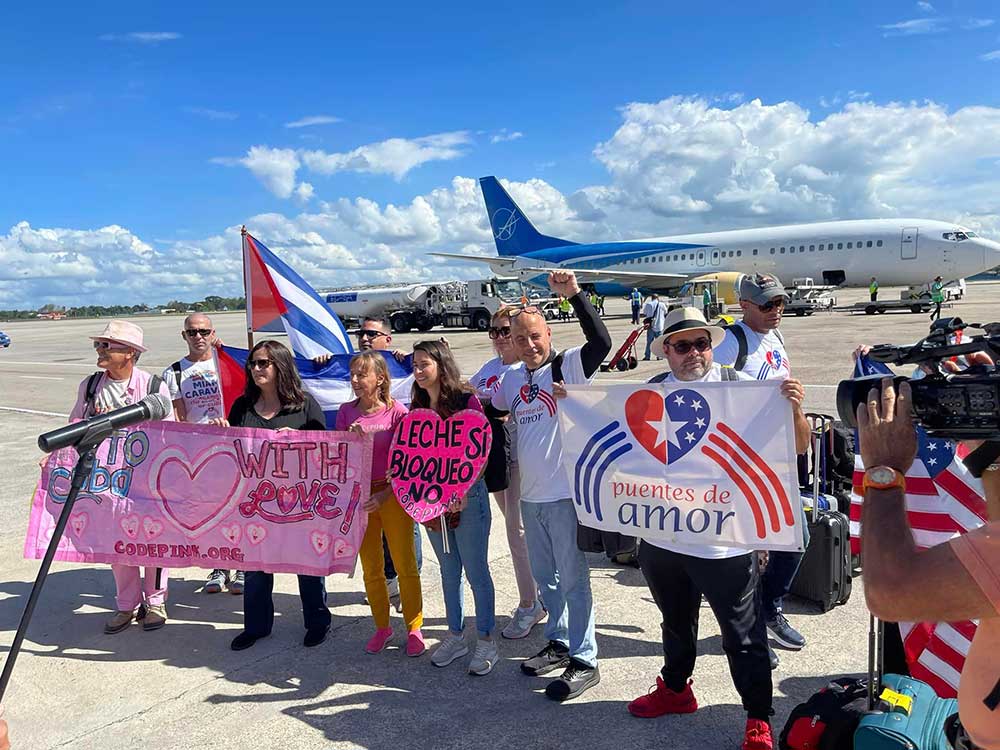
One of the entities with which PDA collaborates most closely is Codepink, which expressly opposes US sanctions on countries like Venezuela, Iran, North Korea, and Cuba, all considered totalitarian regimes.
An analysis by the Capital Research Center, a conservative think tank based in Washington that investigates NGOs, states that Codepink often uses the same language as the governments it supports. It also points out, referring to the campaign “China Is Not Our Enemy,” that the organization “promotes some questionable and strangely specific achievements of the Chinese government.”
Jodie Evans and Medea Benjamin, two left-wing activists, have been leading the organization since they founded it 21 years ago. Of the two, Benjamin has a much closer relationship with the island. She lived there for four years in the ’80s and returned two decades later to work on community projects alongside Global Exchange, another NGO she directs. She has also authored three books on food and agriculture in Cuba.
The activist, who frequently accompanies Lazo in delivering donations across the island, also heads the Benjamin Fund, a foundation created with family assets valued at nearly 40 million dollars in 2020. The Benjamin Fund provides funding each year to dozens of NGOs, including Codepink, which receives the majority of its funds.
Alongside Codepink and PDA, a third organization collaborates regularly: Proximity Cuba. Registered in Florida, it specializes in managing academic and exchange trips, also under the People-to-People program. It partners with Cuban state tourism companies such as Amistur and Transtur.
Currently, all three NGOs offer a tour of the largest of the Antilles, with groups of up to 30 people, at a cost ranging from 1900 to 2100 USD. The People-to-People program, for which they obtain a license from the Office of Foreign Assets Control (OFAC), specifies that these trips should aim to improve contact with the Cuban people, promoting their independence from the authorities. However, the schedule of activities includes visits to the Fidel Castro Ruz Center, the Memorial of Denunciation (a museum of the Ministry of the Interior), and meetings with institutions and mass organizations created and managed by the government. These include the Federation of Cuban Women (FMC, by its Spanish acronym) and the National Association of Small Farmers (ANAP, by its Spanish acronym).
These companies and NGOs have in common that a significant portion of their income, both donations and transactions, depends largely on the policies of rapprochement between Cuba and the United States that encourage travel and investment opportunities. They also share sympathies for the government, which are rewarded with the permits they need to operate in a country governed by a totalitarian system.
Additionally, PDA has formed alliances with other organizations that also defend Cuba from anti-embargo policies. This includes Global Health Partners, an NGO that has been sending medicines and supplies worth 131 million dollars for 22 years. Its director, Bob Schwartz, also organized the visit to Cuba by one of the defense lawyers that represented the five Cuban agents imprisoned in the United States.
In this network of alliances, you can also find the Global Anti-Blockade Movement for Cuba (NEMO) and the Democratic Socialists of America (DSA). According to the official news agency Prensa Latina, NEMO was involved in around 400 “acts of solidarity with Cuba” in 2022, just one year after its founding.
DSA, on the other hand, was founded in 1982 and currently has 85,000 members, including congressmen, representatives, and Democratic supporters in general. It is recognized as the largest socialist organization in the United States to this day.
As an organization, PDA (Puentes de Amor) had an agenda that included various demands directed towards both the Trump and Biden administrations in the United States, demands that were also held by the Cuban government. These demands included the reopening of the U.S. embassy, the resumption of the family reunification program, the sending of remittances, among other requests. Gradually, the Biden administration has been adopting these measures.
In May 2022, the State Department announced the implementation of a series of measures to ease those imposed by Trump. Days later, Lazo released a statement on behalf of PDA, stating they were “welcoming the announced changes… does not mean that we are satisfied or that we will demobilize. We will not do so as long as Cuba remains on the list of state sponsors of terrorism. We will not do so as long as the more than 240 sanctions left by Trump remain, as a macabre farewell gift. We will not do so as long as the blockade against Cuba exists.”
In this regard, Lazo has already organized several events, including a protest in front of the White House last June, with the support of Codepink, to demand the removal of Cuba from the terrorism list.
Not coincidentally, the Cuban government’s discourse and media agenda have also moved in that direction. In fact, a few weeks ago, they announced the start of the campaign “Cuba Lives and Resists!” with the aim of gathering one million signatures to request removal from the list.
Due to these coincidences in the discourse, and even in the timing of their actions, there is doubt about whether PDA is or is not a political lobbying organization that serves the interests of the Cuban government.
This is also the reason why Senator Marco Rubio requested that the Federal Bureau of Investigation (FBI) open an investigation against PDA and Carlos Lazo for alleged violation of the Foreign Agents Registration Act. This regulation requires all individuals or groups representing the interests of a foreign principal before any U.S. agency or official to be registered officially and to disclose their activities, something that the professor has done on several occasions when meeting with senators and congressmen to call for an end to sanctions.
The previously-mentioned investigation by The New York Times also points out that none of the organizations that disseminate Chinese government propaganda are registered as required by that law. One of the main nodes of this network is Neville Roy Singham, who is the husband of Jodie Evans, founder of Codepink.
Lazo responded to the media, stating that Codepink was “under attack,” using the same language that the regime uses to denounce publications against it. He accused The New York Times of defamation against the organization and claimed that it had the same intention as Marco Rubio: to allegedly silence voices that seek to improve relations between the United States and other countries. According to the professor, Rubio requested an investigation into him for meeting with Díaz-Canel and other regime authorities.
In his response letter to the Senator, which was also shared by OnCuba, he stated: “I will meet with whomever I need to meet in order to request the lifting of sanctions against the Cuban people.”
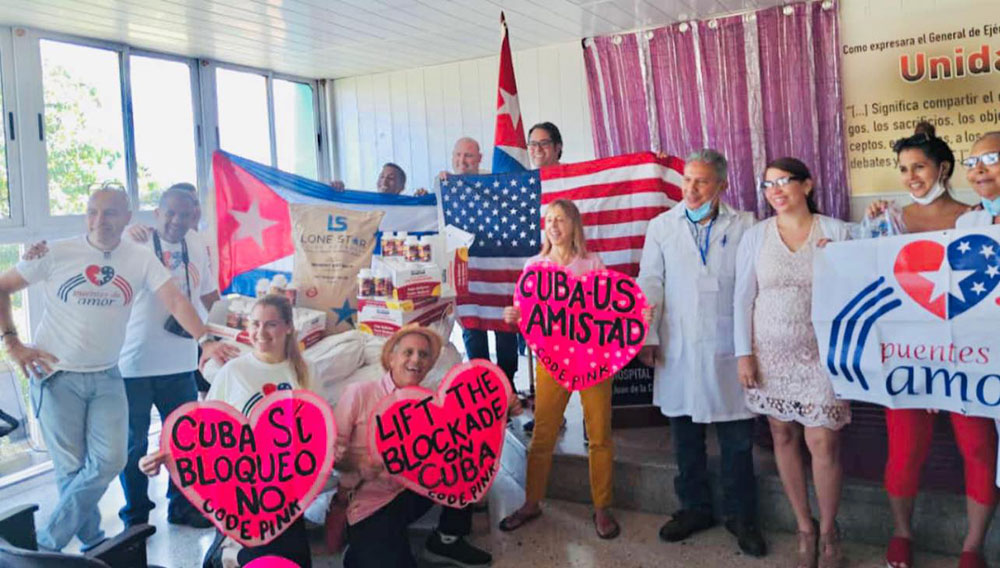
In a school hallway, with his back to some metal lockers and resting against the wall, Lazo encourages his students to sing a Buena Fe song. “Come on, let loose! Fire it up, guys, fire it up for the union!” he enthusiastically shouts at them. These are expressions the students are already familiar with because it’s the way their Spanish teacher, an individual with a distinct Cuban accent, charismatic and talkative, speaks. Much more informal than what a teacher typically is.
He introduces himself as a “dreamer and idealist.” He claims that every time the students have a dream, he responds with, “Let’s do it.” Just like that, from an idea thrown into the air during a class, he always tells the story of how Fábrica de Sueños and later Puentes de Amor were born, the projects that transformed Lazo from being one of the nearly two million Cubans who emigrated to exile, to becoming one of the most well-known activists and advocates that the regime can count on today.
